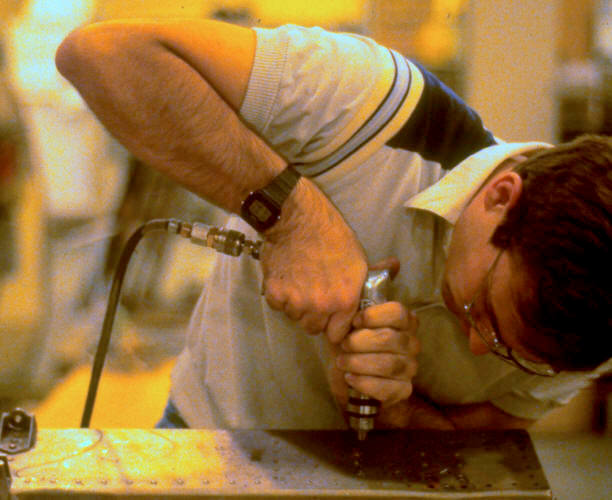 |
 |
| Heavy load on arm, hands | Heavy pinch force |
Through the ages, countless tools and machines have served to reduce exertion. The search for even more ways to reduce excessive force is one of the defining areas of contemporary workplace ergonomics.
Production Issues
Excessive force can slow down a task and interfere with the ability to perform it well. A good example is the difference in time that it takes to open a rusty bolt compared to a clean bolt.
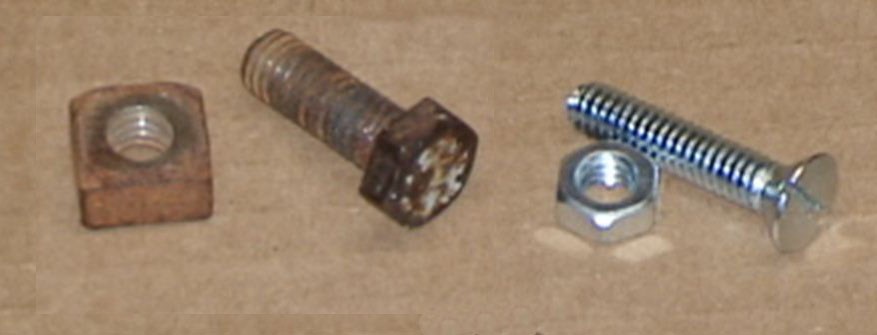
Rusty bolt vs. clean bolt
A new bolt turns easily and takes minimal time. But a rusty bolt takes more effort and often a significant amount of extra time.
Furthermore, when we exert at high levels, we lose the ability to control muscles accurately, thus risking errors and accidents. Consequently, almost anything that minimizes the exertion required for a task will make it easier and, typically, faster to perform.
Employee well-being
Excessive force can overload the muscles, creating fatigue and the potential for injury. Force is one of the risk factors for musculoskeletal disorders, and indeed, “overexertion” is a common category of workplace injuries.
Strategies for improvement
Levers
Conveyors and slides
Grips
Fixtures
Counterbalances
Powered equipment
Reduce resistance
Make things lighter
Make things heavier
Gearing
Decrease leverage
Transfer the load
Additional
Terminology
Measurements and guidelines
Problem-solving strategies
The following are a number of generic approaches to reducing force. The context is that of trying to identify feasible solutions to a problem. The goal of this page is to describe each strategy and show practical examples so that you can use it as a type of checklist: “Can we use a lever here? Or can we use a conveyor or slide?” etc.
Levers
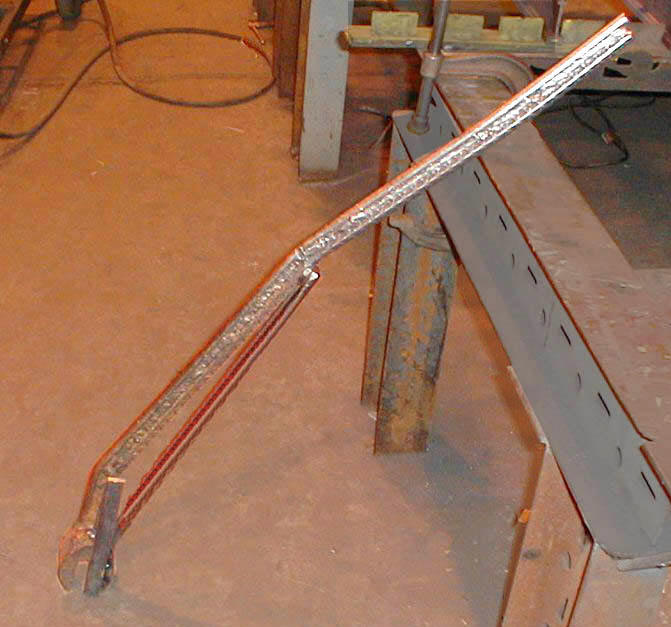 |
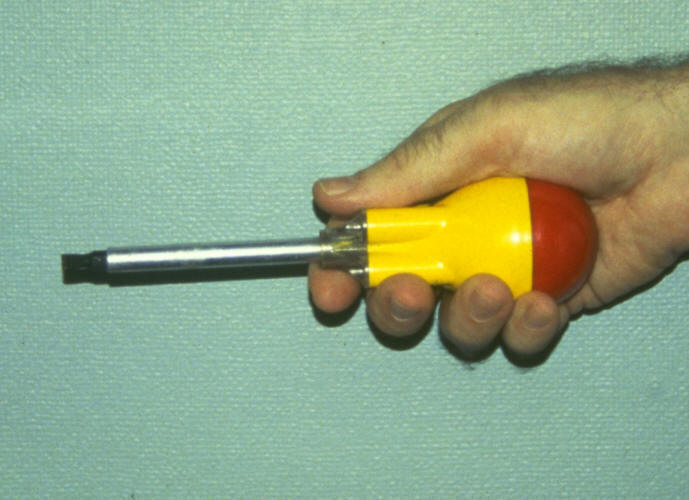 |
 |
| Classic pry bar | Ball-handled screwdriver | Hinged handle screwdriver |
Levers are as old as the earliest humans, and even used by other primates as a way to reduce exertion. Levers are usually thought of in terms of lifting large, heavy objects, but can be applied in virtually any circumstance, such as with a screwdriver. The ball handle above doesn’t look like a lever, but the larger diameter provides more leverage. Even more powerful is a hinged handle, above right. See Hand tools: Levers
Use conveyors and slides
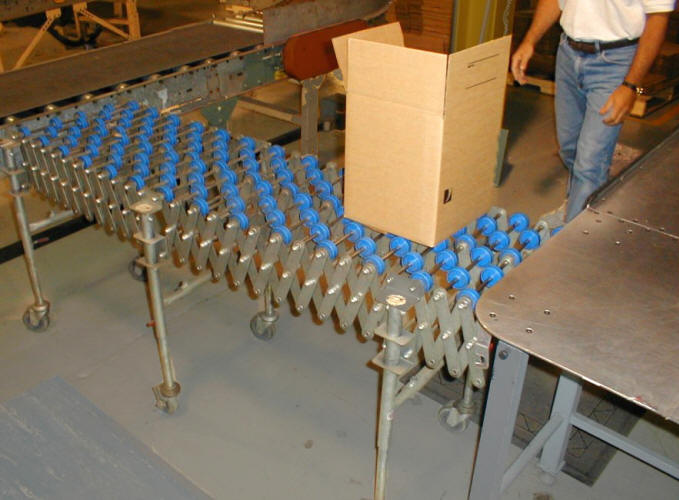 |
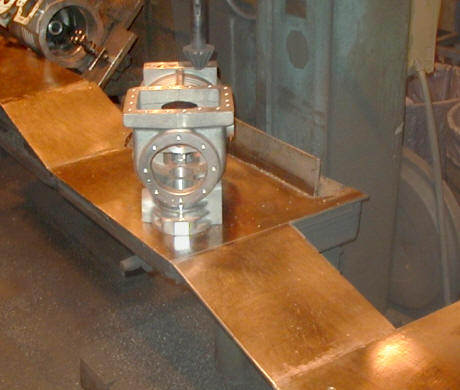 |
| Flex conveyor | Basic slide |
Conveyors are ergonomic devices, even though we don’t normally think that way. One hundred years or so ago, there were no conveyors. Everything was picked up and carried by hand.
Slides or skids are similar to conveyors, but simpler in that they have no rollers or moving parts. Conveyors are usually better, but slides can be effective and inexpensive in the right settings. To reduce the strain from carrying a load, all it takes sometimes is a small support of some type. See Material handling: Conveyors, Slides
Improve grips
 |
 |
| No handhold | Handhold |
It is easier to use a full hand grip (a power grip) than just the fingers alone (a pinch grip). A good example is carrying a box or tote — boxes with handholds take less exertion to carry. Consequently, with a good grip, you can accomplish the same task with less effort.
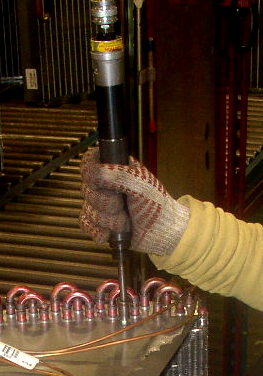 |
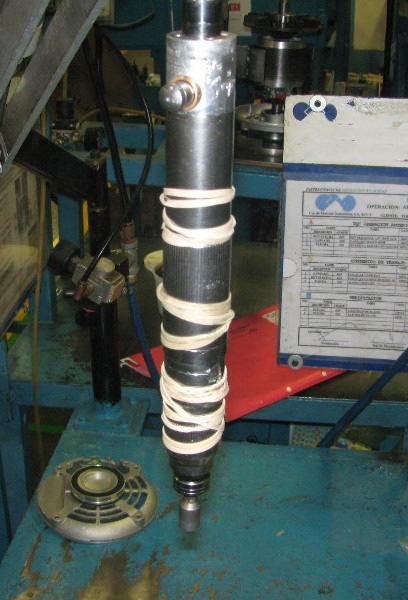 |
 |
| Slippery, using glove | Employee quick fix | Friction wrap and collar |
If a grip is slippery, you must squeeze harder to accomplish the same task. One common improvement is to cover the grip with a material that provides higher friction. In cases where the force applied is coaxial to the grip, providing a collar or stop on the grip can reduce grasping force.
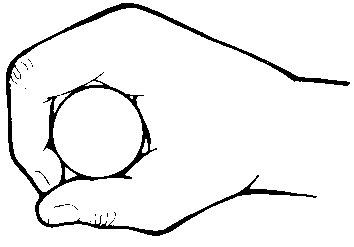 |
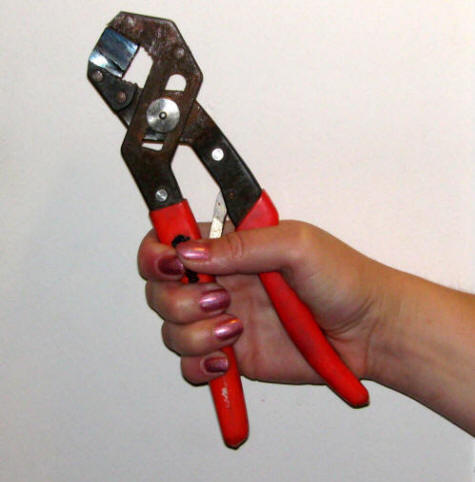 |
| Maximum strength | RoboGrip incorporates this grip size concept |
For maximum strength, the grip size should be roughly that which permits the thumb and the forefinger to overlap slightly. If the grip is significantly larger or smaller than that, more force is needed to accomplish the same work. The RoboGrip uses a mechanism that takes advantage of this fact. See Hand tools: Grips; Material handling: Totes.
Use fixtures
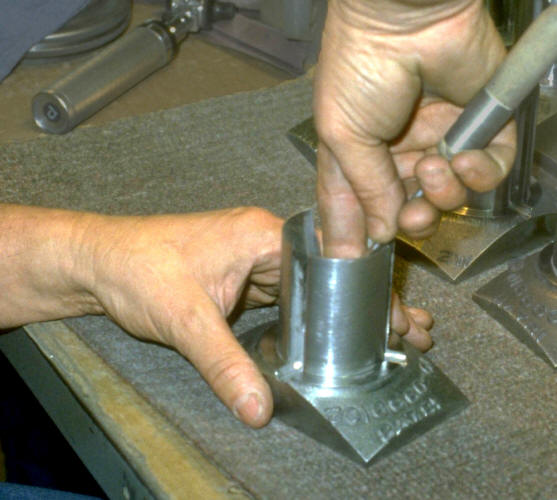 |
 |
| Before: Hand as fixture | After: Fixture |
Using the hand as a fixture increases exertion and wastes effort. If you simply provide a mechanical fixture for the object, it can become much easier to work on. Furthermore, the fixture frees up both hands to do the work. See Workstations: Bench-top fixtures, Free-standing fixtures; Hand tools:Handheld fixtures.
Use counterbalances
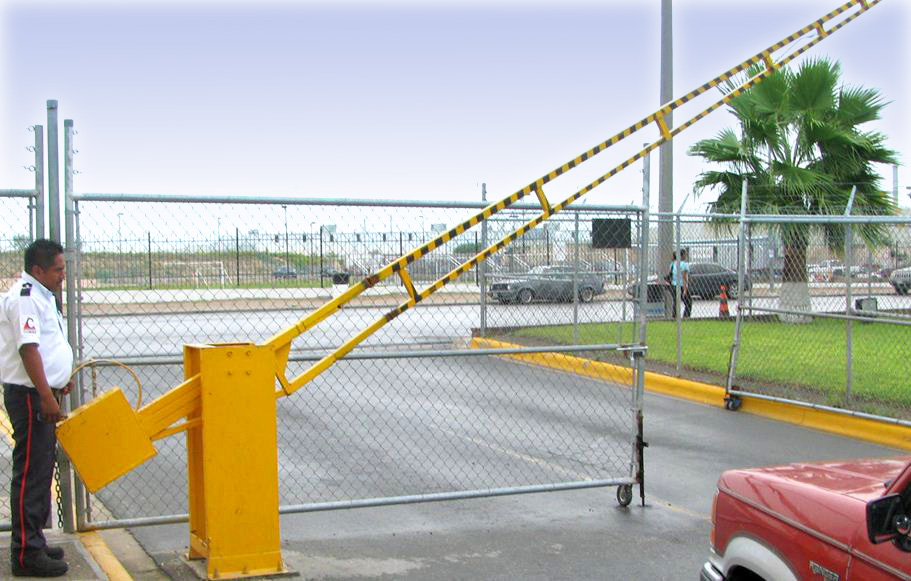 |
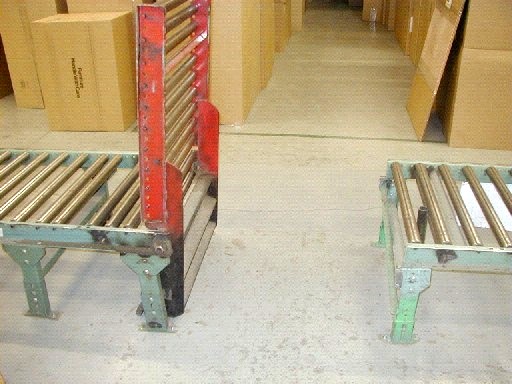 |
| Traditional counterbalance | Counterbalanced conveyor gate |
Many loads can be counterbalanced to make them virtually weightless. This is ancient technology that can still be effective today and at low cost. An in-house maintenance person can usually fabricate an inexpensive counterbalance for a conveyor gate that is easy to open. See Material handling: Conveyor gates
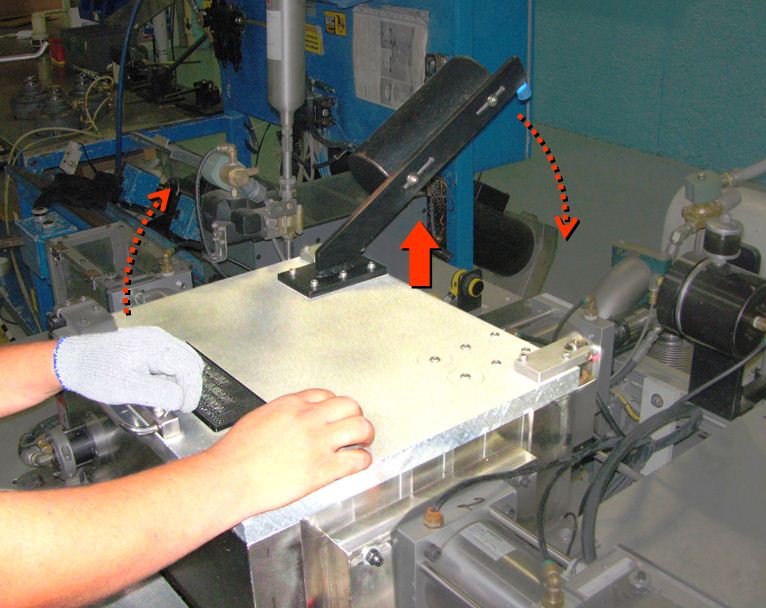 |
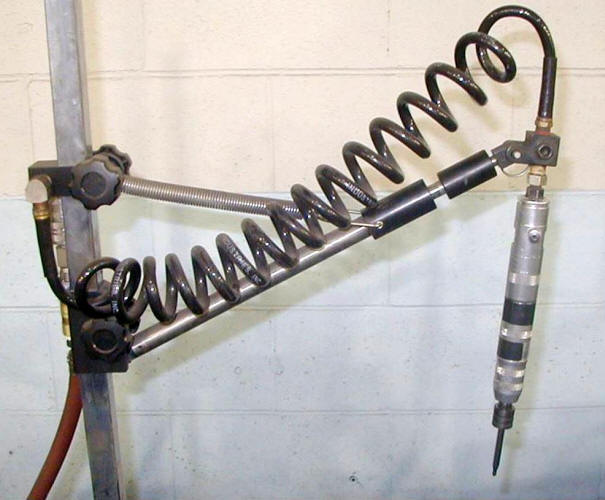 |
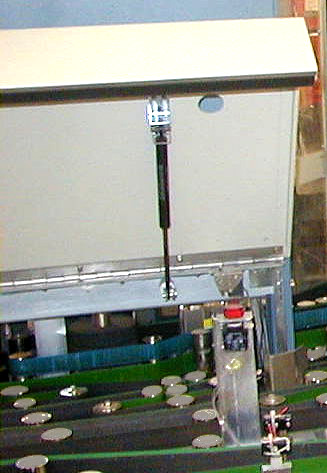 |
| Counterbalance on heavy cover to pressurized testing unit | Spring counterbalance on tool | Air cylinders on access panel |
A heavy weight on an arm or pulley is the traditional technique, but multiple other methods can be used, in particular, overhead spring suspension and cylinders (like those on car hoods or self-closing doors). See Hand tools: Arms and counterbalances; Machine Operations: Covers and doors; Maintenance: Access panels
Use power tools, equipment, and assists
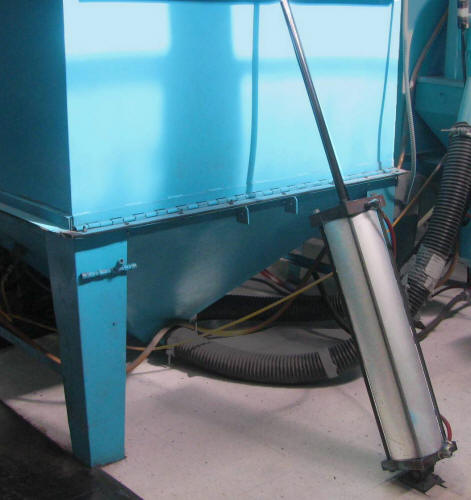 |
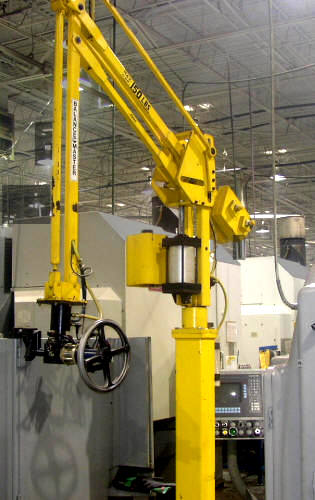 |
| Power cylinder | Manipulator arm |
Using some sort of powered device is perhaps the most self-evident strategy in modern industry for reducing force. Machines and power tools of all types fit in this category. Air or hydraulic cylinders are particularly useful where moderate force is needed. Manipulator arms have become common in recent years to position heavy loads with minimal exertion. See multiple examples in Material handling and Hand tools.
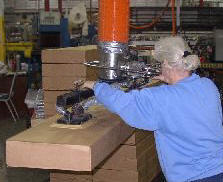 |
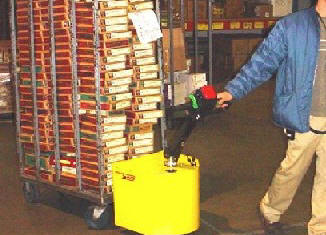 |
| Vacuum hoist | Tugger |
A shortcoming, however, is that powered equipment is often the only option that is considered. Thus, deliberations miss alternatives that may be equally or more effective at less cost.
Reduce resistance
This strategy has to do with changing the characteristics of the item that creates the force. When you are confronted with a heavy force, one of the questions to ask yourself is: “Can we make a change in the internal characteristics of the load to reduce resistance.” The solutions depend on the nature of issue, but this question addresses the problem in a different light than the other strategies.
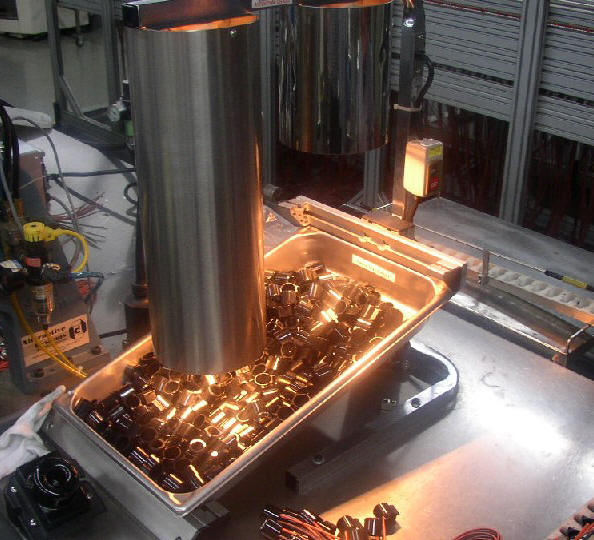 |
 |
| Heat lamp to soften plastic parts | Add oil to a rusty bolt |
Certain plastics can be heated to make them pliable and easier to insert or manipulate. The photo shows a restaurant lamp used in an assembly operation to keep plastic plugs warm and soft.
Adding oil to a rusty bolt is a commonplace solution. However, the example helps show the point of reducing resistance — it helps you think of other types of solutions than, for example, using a bigger wrench.
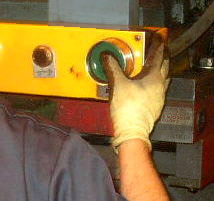 |
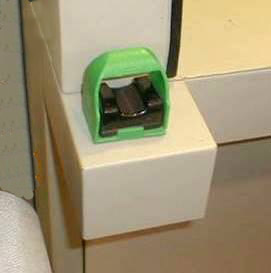 |
| Old “palm” buttons | Photoelectric finger sweeps |
Sometimes, the force needed to do a job can be reduced by changing specific mechanisms within the equipment. A good example is replacing old-fashioned palm buttons to operate machines (which can require a heavy push) with finger sweeps (which require no force). See Machine Operations:Controls
 |
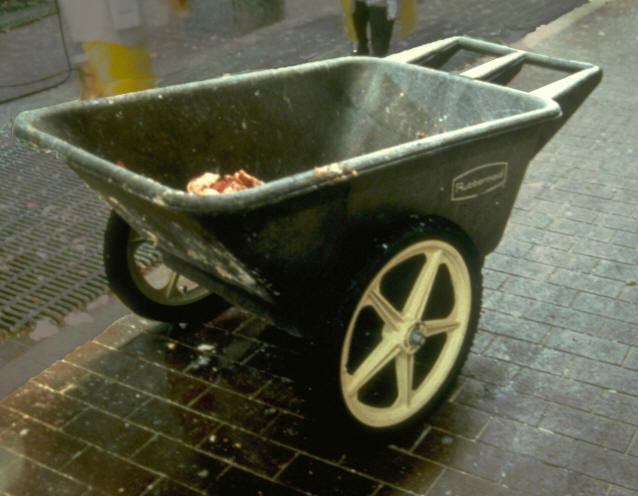 |
| Heavy push: tiny wheels, rough floor | Easier push: large wheels, smoother floor |
Similarly, moving heavy carts can be improved with large, good quality wheels that use bearings. A smooth floor makes a difference as does a good handle. See Material handling: Air casters, Wheels.
Adding slippery surfaces where materials need to be slid also can fit into this category. See Workstations: Surface material.
Make things lighter
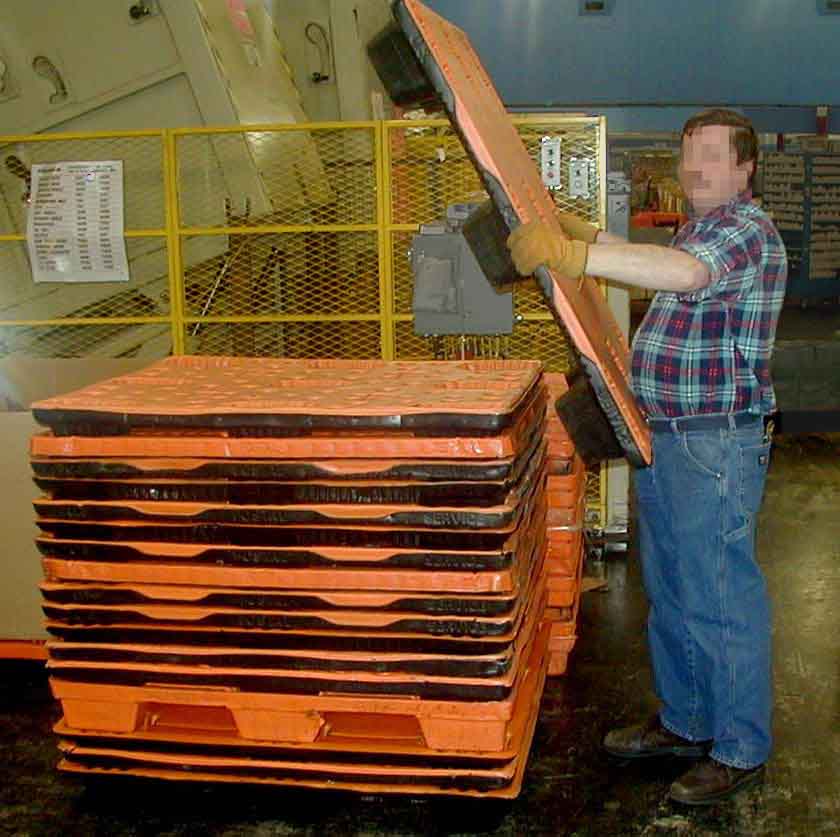 |
| Plastic pallet |
The item itself can sometimes be made lighter, without sacrifice to its structure. A good example is the use of plastic pallets, which are less than half the weight of a standard wood pallet. These pallets have other ergonomic benefits too, in that they slide easier and can nest, which means more can be stacked without going too high. Further advantages of plastic pallets are that they are longer lasting plus eliminate safety hazards of nails or splinters. See Material handling: Pallets
Other common techniques for reducing the weight of materials are to switch from steel to aluminum or add holes to solid materials.
Making things lighter is a common strategy, but is probably relied on too much. It involves a shortcoming in certain situations where reducing the weight of a single load necessitates lifting smaller loads more frequently. The overall physical strain on the body may be less with more frequent lifts of smaller loads, but typically productivity is also reduced. Other, less well known strategies such as using slides can be much more effective — if you’re sliding a load on rollers or other slippery surface, it may not matter how much the load weighs.
Make things heavier
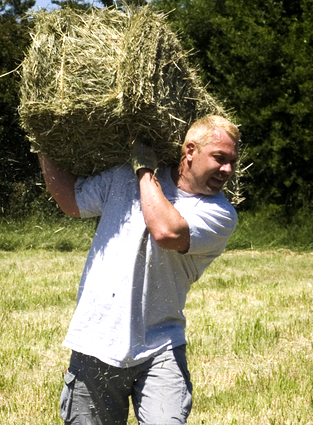 |
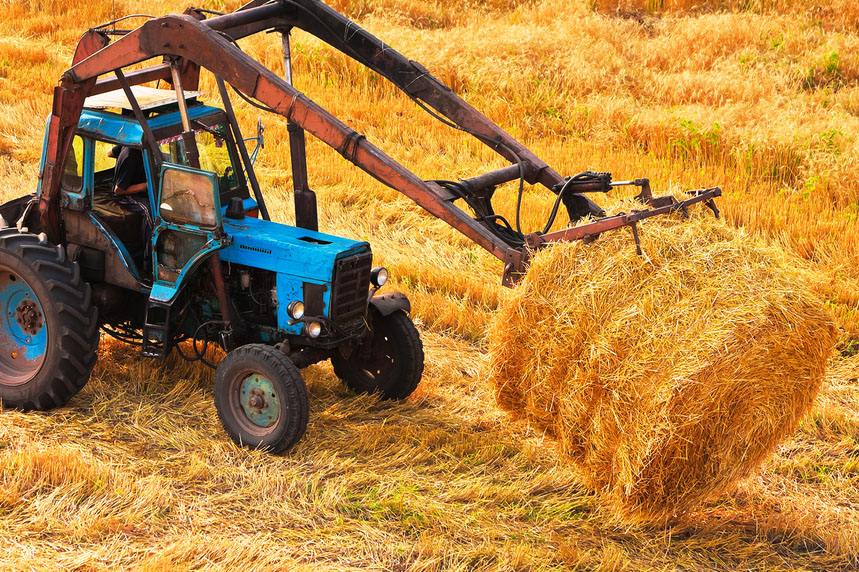 |
| Heavy lift | More efficient |
A non-intuitive approach is to make the loads heavier. By itself, this strategy does little, but it can have two benefits:
- Make the use of mechanical solutions feasible.
- Reduce the temptation to lift the load manually.
A good example is the shift in agriculture from small square bales to much large round ones. One lift of a large bale with a tractor moves the equivalent of 30-40 small square ones, so is more efficient. Furthermore, it wouldn’t occur to anyone to try to lift a large round bale of hay, so there is no temptation to try and thereby risk injury.
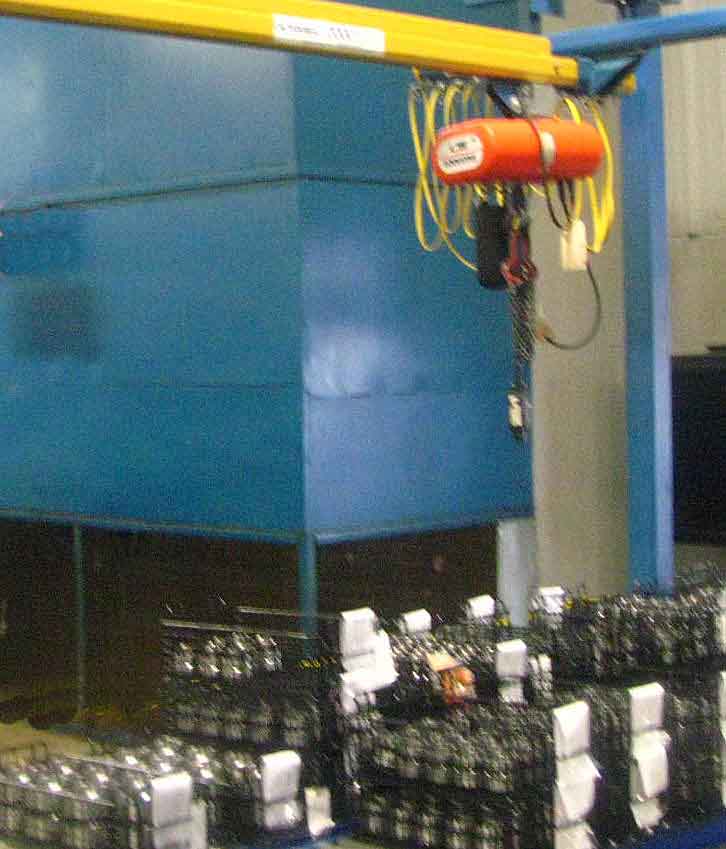
Unused hoist? Switch to larger baskets.
An all-too-common situation is to install a hoist that stays unused, since employees are in the habit of lifting manually and consider it too much bother to use the slower hoist. So a potential solution is to switch to larger containers. The load would then be too heavy to try to lift by hand, plus one lift with the hoist moves more material, so makes it worth the effort.
Gearing
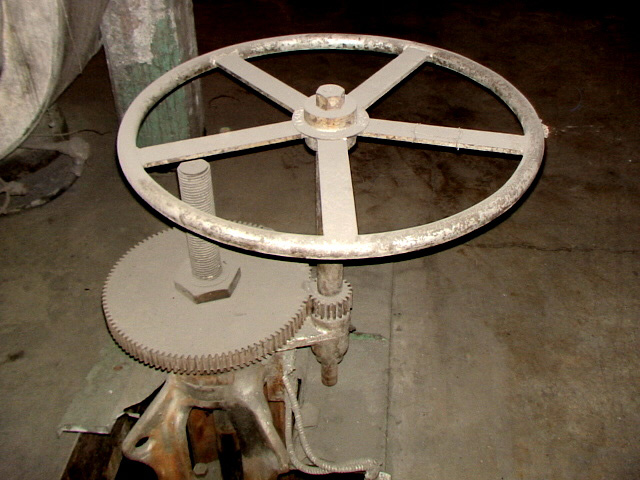 |
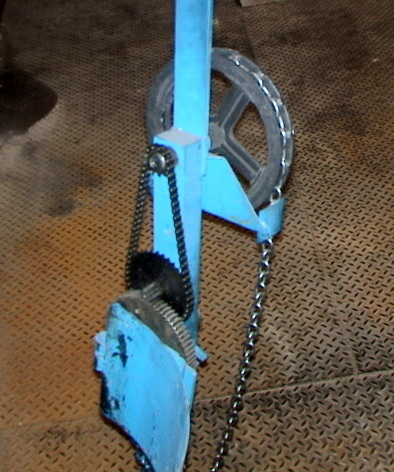 |
| Gearing for a pipe valve | Gearing for pouring a ladle of molten metal |
Gearing provides mechanical advantage, useful for things that turn or rotate. The number of motions required increases, but the force is less.
Reduce leverage
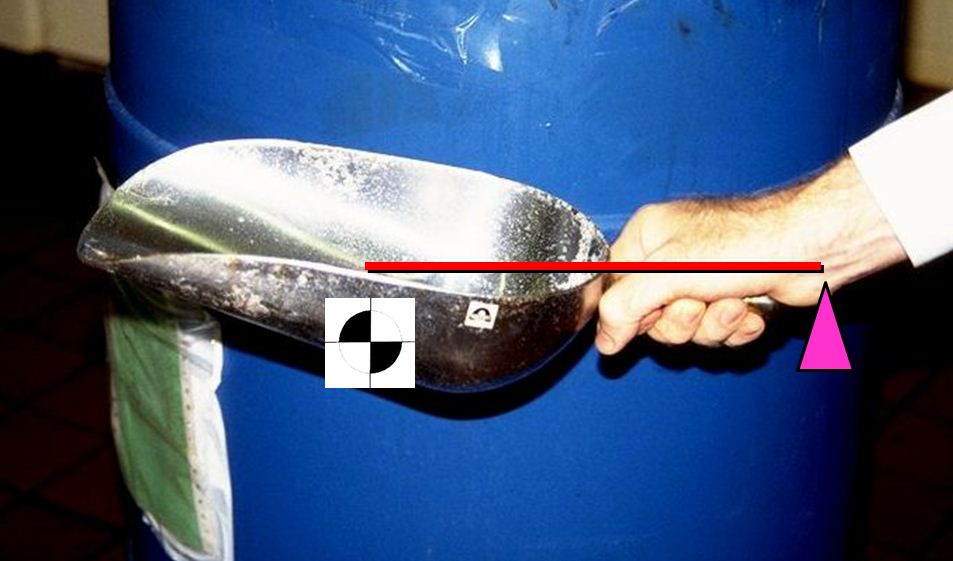 |
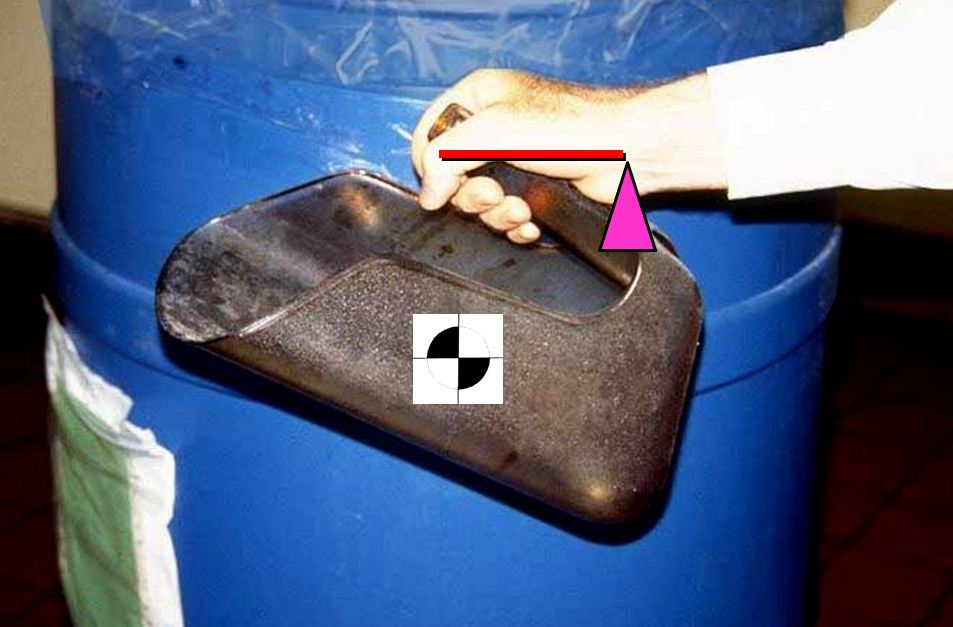 |
| Grip away from center of gravity | Grip above center of gravity |
Levers can work to disadvantage too. An example is a traditional scoop. As shown in the left-hand photo above, the handle creates an unintended lever: the wrist is a fulcrum and the load is far to one side. In the unconventional design above right, the center of gravity is below the hand, thus, the “lever” is shorter and there is less strain on the wrist.
Consequently, it is important to be alert for mechanical disadvantage in tools and equipment. In these situations, the “lever” is usually unintended and may not look like a classic lever at all, even though it has that effect.
Transfer the load
 |
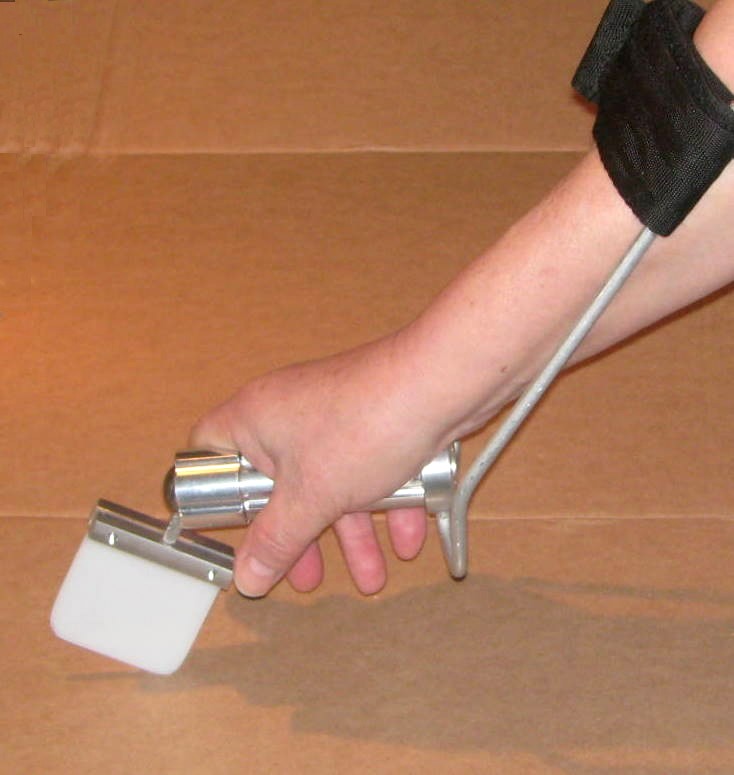 |
| Backpack belt | Forearm brace |
Sometimes it is possible to shift a load from weaker muscles and joints to stronger muscles and joints. The classic example is the backpack belt, which shifts the load from the spinal column to the hips, thus bypassing the sensitive lower back. A more unusual example is a forearm brace for certain hand tools, which shifts the load from the wrist to the full arm.
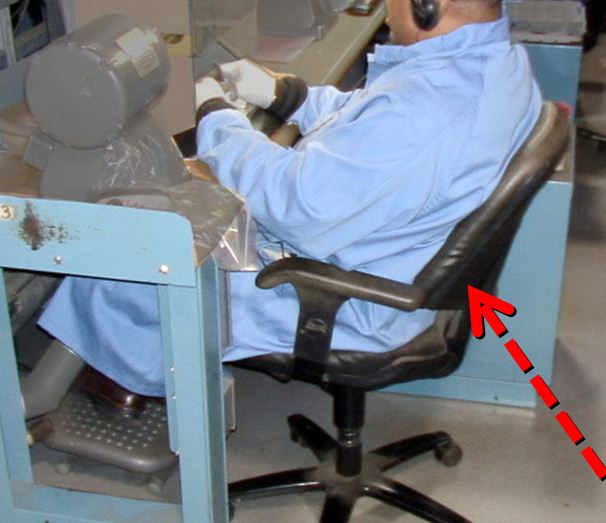 |
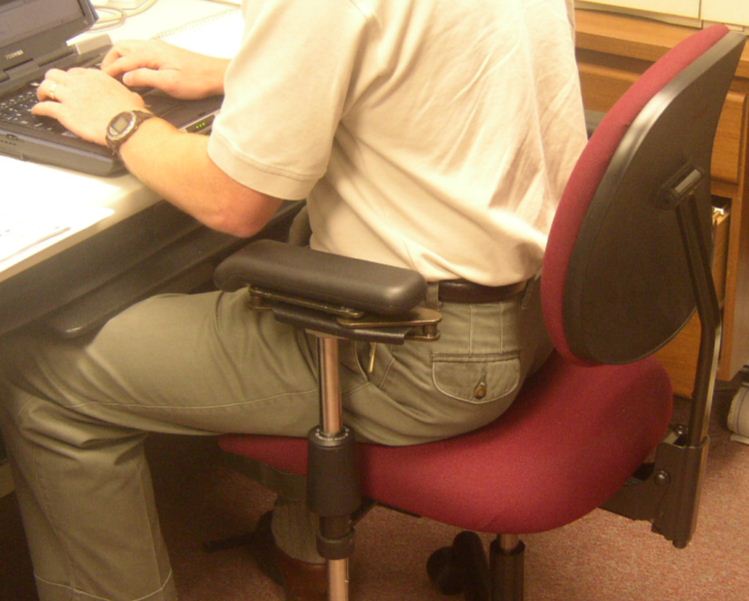 |
| Leaning back: Weight transferred to the chair | Sitting upright: Weight compresses the spinal discs |
The most widespread application of transferring the load is the chair backrest, although it is seldom recognized as such. When you lean back when sitting, much of the weight of the upper body is shifted to the chair and off of your spine. In contrast, when you sit upright, especially with minimal or no lumbar support, all of the weight of the upper torso falls on the discs in the lower back.
Terminology
The terms force and exertion sometimes have specific technical meanings in the context of workplace ergonomics. Exertion is the internal tension produced by muscles and transmitted through tendons to produce force. Force is the externally observable result of a specific movement or exertion. However, in everyday language, including on this website, the two terms can be used interchangeably.
In the context of workplace ergonomics, force is a term that is relative to the affected muscles and is often used in instances not typically considered in daily life. For example, the pinching motions used to assemble small products like electronics are a crucial issue for the hand, although tasks of this type would ordinarily be considered light work.
Duration is also an additional consideration when evaluating force. A force that needs to be sustained for several minutes has quite a different implication from that of a few seconds and is referred to as a static load. See Fatigue.
Measurements and guidelines
There a number of approaches to measurements and several quantitative guidelines. SeeBiomechanics, Lifting guideline, and Force guidelines.
